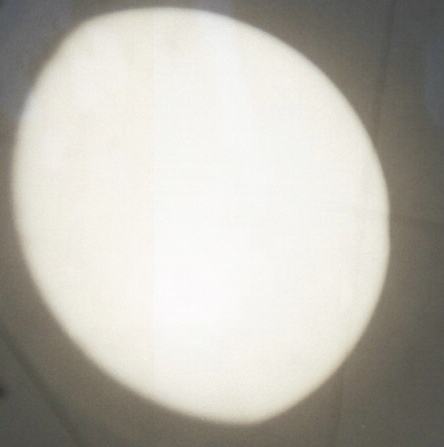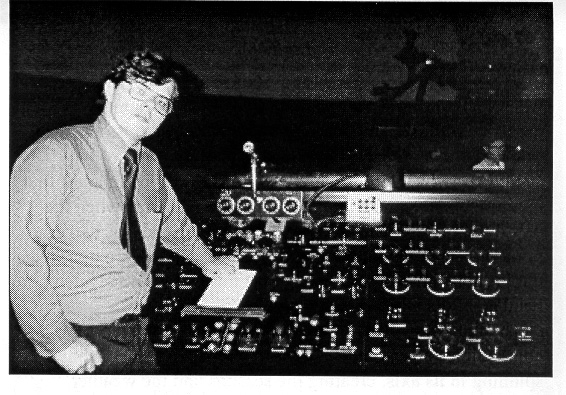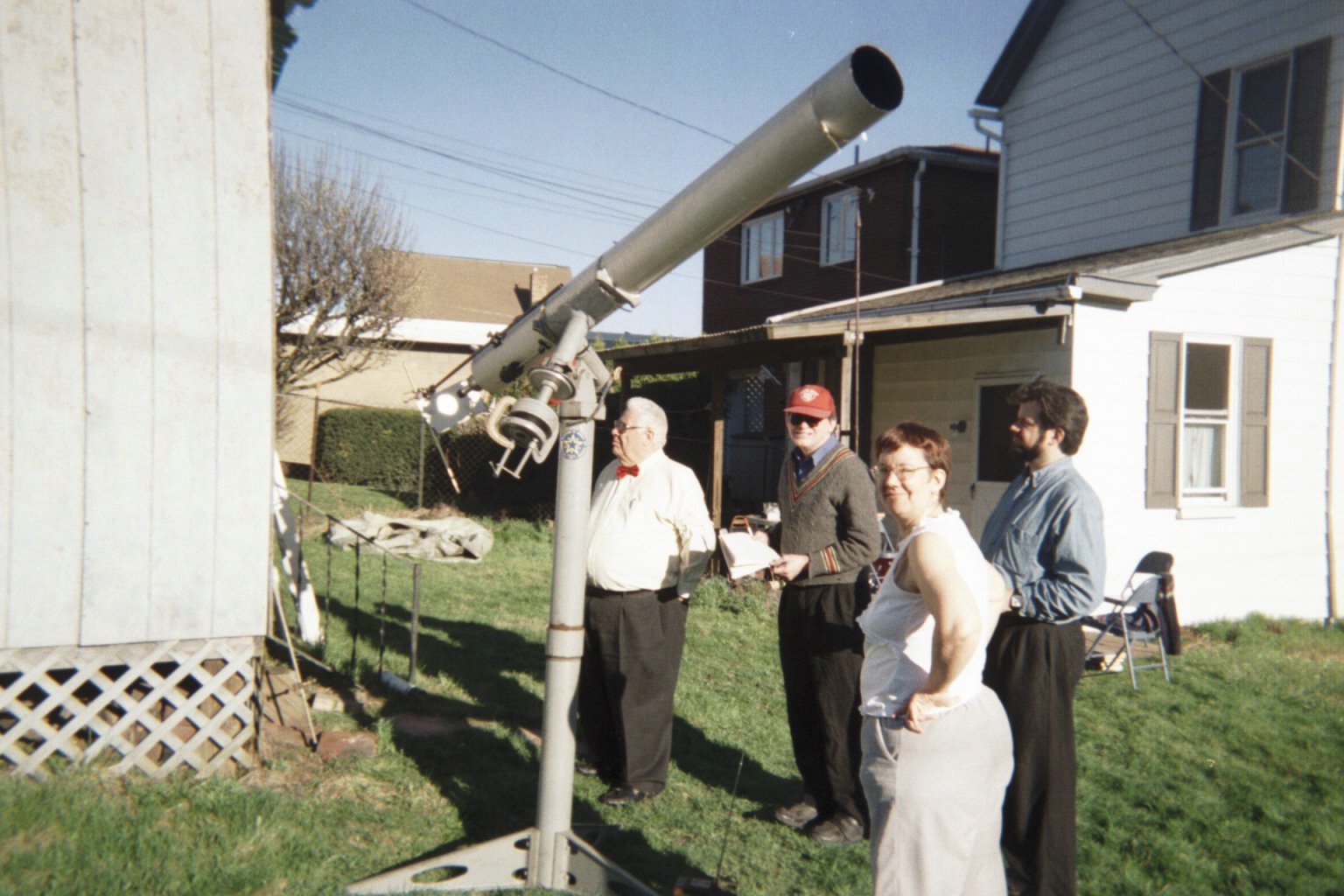2005 Eclipse of Sun - East Pittsburgh
Observing Session of
Hybrid Total/Annular Eclipse of the Sun
Observed as Very Slight Partial Solar Eclipse at
Christina Alley Observatory, East Pittsburgh PA
2005 April 8

 Photographs of the Hybrid Total/Annular Eclipse of the Sun, seen as a very slight partial solar eclipse at the Christina Alley Observatory in East Pittsburgh, Pennsylvania. Photographs taken by Christina Alley Observatory Director
Francis G. Graham, Founder of the American Lunar Society and Professor of Physics and Astronomy at Kent State University.
Photographs of the Hybrid Total/Annular Eclipse of the Sun, seen as a very slight partial solar eclipse at the Christina Alley Observatory in East Pittsburgh, Pennsylvania. Photographs taken by Christina Alley Observatory Director
Francis G. Graham, Founder of the American Lunar Society and Professor of Physics and Astronomy at Kent State University.
The photograph on the left (top photograph on some browsers) was taken at maximum eclipse; the second photograph on the right (bottom photograph on some browsers) was taken shortly after maximum eclipse. This eclipse was viewed with a 16-centimeter (objective lens of approximately 6.5 inches aperture) f/15 refractor telescope, which is normally stationed at the Christina Alley Observatory (using projection method of display of image); in this case, the telescope was mounted just outside the Observatory.
In the two photographs, the Moon is seen as a tiny "nibble" on the right side of the solar disk.
(Click on an image, to see an enlarged view of the photograph.)
Observing Session of
Hybrid Total/Annular Eclipse of the Sun
Observed as Very Slight Partial Solar Eclipse at
Christina Alley Observatory, East Pittsburgh PA
2005 April 8
Authored By
Glenn A. Walsh
Sponsored By
Friends of the Zeiss
This Internet Web Page: <
https://buhlplanetarium4.tripod.com/eclipse/hybrid2005.html >
Internet Web Cover Page: <
http://www.friendsofthezeiss.org >
Electronic Mail: <
hybrid2005@planetarium.cc >
Internet Web Site Master Index for
the History of
The Buhl Planetarium and Institute of Popular Science,
Pittsburgh
Other Solar Eclipses ***
Eclipse of the Sun / Solar Eclipse: Tips For Safe Viewing
On 2005 April 8, (Friday afternoon and evening in Pittsburgh), a Hybrid Eclipse of the Sun, which through the course of the eclipse varied between a Total Solar Eclipse and an Annular Solar Eclipse, began in the eastern edge of the Eastern Hemisphere of Earth (where the date was actually 2005 April 9) but traveled primarily through the Western Hemisphere. The region of Pittsburgh, Pennsylvania USA was on the very northern edge of the eclipse path and would only experience a very slight Partial Solar Eclipse.
Detailed observations of this very slight Partial Solar Eclipse were made at the Christina Alley Observatory in the Pittsburgh suburb of East Pittsburgh, Pennsylvania. The Director of this private observatory,
Francis G. Graham, is Assistant Professor of Physics and Astronomy at Kent State University (who works at both the main campus in Kent, Ohio and the East Liverpool Campus in East Liverpool, Ohio), Founder of the American Lunar Society, a former long-time (most of the 1980s) Planetarium Lecturer at Pittsburgh's original
Buhl Planetarium and Institute of Popular Science, and a member of the Steering Committee of
Friends of the Zeiss (new non-profit organization working for the preservation and use of the original building, equipment, and artifacts of the original Buhl Planetarium). Professor Graham was accompanied by his wife and three colleagues in this observation.
The telescope used for these observations (observations made using projection method of display of image), the primary instrument of the Christina Alley Observatory, is Professor Graham's 16-centimeter (objective lens of approximately 6.5 inches aperture) f/15 refractor telescope. Although this telescope is normally stationed inside the Observatory, for this event the telescope was mounted just outside of the Observatory, as the Observatory building was undergoing repairs at the time. It is not unusual for this telescope to be used for observations in other locations. On 2004 June 8, this telescope was one of four instruments (three telescopes and a set of large binoculars) set-up for Pittsburgh's only public observation session, with telescopes, of the historic
Transit of the Planet Venus Across the Image of the Sun, mounted at the
public observation deck of
The Duquesne Incline in the Duquesne Heights section of Mount Washington.
As a result of his observations of this solar eclipse, Professor Graham issued two reports:
Report 2: 2005 April 22
THE LIMITS OF VISIBILITY OF A PARTIAL ECLIPSE OF THE SUN
INFERRED FROM OBSERVATIONS NEAR THE PARTIAL ECLIPSE LIMIT
In 2011, Professor Graham also produced a report for his "Meridian Passage" Electronic Mail Blog, recollecting his observations of this eclipse:
Graham, Francis
"A LOOK BACK TO APRIL 8, 2005." Blog: Meridian Passage 1229.
Electronic Mail Blog 2011 April 8.
Other Hybrid Eclipse Information
From the NASA Web Site

Illustrated in the image above is a Mercator's Projection Map of the World, showing the path of the Hybrid Solar Eclipse of 2005 April 8. As can be seen, the northern edge of this eclipse path straddles the Pittsburgh region.
Telescope and Observers


(Click on an image, to see an enlarged view of the photograph.)
These two photographs show the telescope used for, and the observers who participated in, the observations of the Solar Eclipse of 2005 April 8 at the Christina Alley Observatory in East Pittsburgh, Pennsylvania.
The telescope used, displayed in the second photograph on the right (below on some browsers), is Professor
Francis G. Graham's 16-centimeter (objective lens of approximately 6.5 inches aperture) f/15 refractor telescope, which is normally stationed at the Christina Alley Observatory (but sometimes moved to other locations for
special events). Although normally used inside the Observatory, this telescope was mounted just outside of the Observatory (part of Observatory building can be seen just to the left of the telescope), as the Observatory building was undergoing repairs at the time of the eclipse.
The white house directly behind the observers, in the second photograph, is the residence of Professor Graham, which has been declared the oldest house in the Borough of East Pittsburgh, Pennsylvania, a suburb of Pittsburgh. This house was constructed circa 1883 for Professor Graham's great-great grandfather Dennis Falvey. This approximate date of construction is documented by a circa 1883 photograph showing Mr. Falvey and a little girl, Mary Falvey (daughter of Dennis Falvey and Professor Graham's great grandmother), with the newly built house.
The photograph on the left (top photo on some browsers) shows
Francis G. Graham, Professor of Astronomy and Physics at Kent State University, Founder of the American Lunar Society, and Director of the Christina Alley Observatory. Professor Graham, who was a Planetarium Lecturer during most of the 1980s at Pittsburgh's original
Buhl Planetarium and Institute of Popular Science, is shown in front of the Planetarium Control Console for Buhl Planetarium's
Zeiss II Planetarium Projector, in this 1982 September photograph.
The other observers who participated in the 2005 April 8 Solar Eclipse observations are shown in the second photograph. From left to right, they are John D. Weinhold (former Buhl Planetarium Observatory Volunteer), Glenn A. Walsh (former Buhl Planetarium Observatory Coordinator and Planetarium Lecturer), Theresa M. Graham (in the foreground), and William Blake Hall. This photograph was taken by Professor Graham.
Other Internet Web Sites of Interest
History of the Astronomical
Observatory of
The Buhl Planetarium and Institute of Popular Science, Pittsburgh
History of The Adler Planetarium
and Astronomy Museum, Chicago -
America's First Major Planetarium !
History of Astronomer, Educator, and
Optician John A. Brashear
History of Andrew Carnegie and Carnegie
Libraries
The Duquesne
Incline, Pittsburgh -
Historic Cable Car Railway Serving Commuters and Tourists since 1877 !
Observing Session of
Hybrid Total/Annular Eclipse of the Sun
Observed as Very Slight Partial Solar Eclipse at
Christina Alley Observatory, East Pittsburgh PA
2005 April 8
Authored By
Glenn A. Walsh
Sponsored By
Friends of the Zeiss
This Internet Web Page: <
https://buhlplanetarium4.tripod.com/eclipse/hybrid2005.html >
Internet Web Cover Page: <
http://www.friendsofthezeiss.org >
Electronic Mail: <
hybrid2005@planetarium.cc >
Internet Web Site Master Index for
the History of
The Buhl Planetarium and Institute of Popular Science,
Pittsburgh
Other Solar Eclipses ***
Eclipse of the Sun / Solar Eclipse: Tips For Safe Viewing
Disclaimer Statement: This Internet Web Site is not affiliated with the
Andrew Carnegie Free Library and Music Hall,
Henry Buhl, Jr.
Planetarium and Observatory,
The
Carnegie Science
Center, The
Carnegie Museums of Pittsburgh/Carnegie Institute,
or
The Carnegie Library of Pittsburgh.
This Internet, World Wide Web Site administered by Glenn A.
Walsh.
Unless otherwise indicated, all pages in this web site are --
(C) Copyright 2005,
Glenn A. Walsh, All Rights Reserved.
Contact Web Site Administrator:
hybrid2005@planetarium.cc
Last modified : Saturday, 09-Apr-2011 04:26:54 EDT.
You are visitor number  , to this web page,
since 2005 May 26.
, to this web page,
since 2005 May 26.



